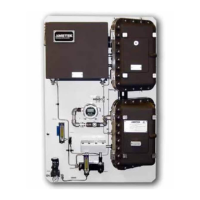4-44 | Model 931S / Model 932S UV Analyzers
Signal
Type (Sensor1 and Sensor2 screens)
Sensor 1 tab:
Select Differential if Sensor1 is connected to J107 of the Micro-
Interface board, or select Voltage if Sensor1 is connected to J105 of
the Micro-Interface board.
Sensor 2 tab:
Select Positive if Sensor2 produces an increasing signal with higher
concentration, or select Inverted if Sensor2 produces a deceasing
signal with higher concentration.
Gain (Sensor1 and Sensor3 screens with Differential Signal Type
selected) For Sensor1, connected to J107, enter the gain value cor-
responding to the jumper setting of JP500 on the Micro-Interface
board.
For Sensor3, enter the gain value corresponding to the jumper set-
ting of JP400 on the Micro-Interface board.
AIN Offset (duty-cyle) (Sensor1, Sensor2, and Sensor3 screens)
The current duty cycle for each sensor (analog inputs) during
steady-state operation at the setpoint. The software will adjust
these values while the sensor is being zero-calibrated. These val-
ues are also displayed on the Analog Inputs dialog box (External
Sensor Input Offset). This parameter is ignored by Sensor1 with
Voltage Signal Type selected.
Interference Compensation
Interference Gas #1 and #2
The analyzer can statically compensate the concentration measure-
ment from the sensor for up to two interfering gases in the sample
stream.
% in Process Gas Stream
The concentration in % of the interfering gas, Gas #1 or Gas #2, in
the sample stream.
Compensation Factor
The factor, corresponding interfering gas, Gas #1 or Gas #2, used
in the interference compensation calculation.

